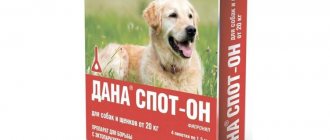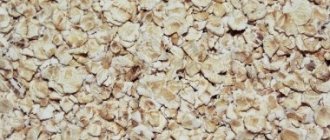Severe stress and the active nature of a dog can lead to nervous breakdowns and various mental problems. In especially susceptible pets, even minor external factors can trigger serious neuroses or changes in behavior that will have to be dealt with throughout their lives. To maintain the health of the animal and mitigate the stressful situation, you can use chemicals and natural herbal remedies. In this article we will look at what sedatives are available for dogs and how to choose them correctly.
Does your dog need sedation?
Regular or one-time stress can seriously harm a dog, especially if the pet has a flexible psyche and emotionality. To eliminate the influence of external irritants, a variety of drugs are used. They reduce the impact of an unpleasant factor and reduce the overall sensitivity of the body to stress. Dog sedatives may be helpful in the following situations:
- drive;
- temporary separation from the owner;
- visiting a veterinarian, hair salon;
- holidays accompanied by noise (loud music, explosions with fireworks);
- pregnancy period and birth of offspring;
- increased excitability of males, estrus of females;
- aggression;
- the experience of loneliness.
All medications are aimed at normalizing the functioning of the dog’s nervous system. More often they contain mild components that do not cause allergies or other adverse reactions.
To choose the most suitable remedy, you should contact your veterinarian. Even before the first dose, you should carefully read the instructions for use.
How to calm a mad puppy
A playful puppy is a big problem!
Especially when you can’t calm him down. This can cause a lot of trouble. Bitten hands, scratches on legs, chewed things and much more!
In order to prevent such troubles, the puppy needs to be calmed in the following ways:
- Take the puppy by the scruff of the neck, shake it and scold it to calm it down. You can also grab it in the neck area and press it to the floor and scold in a menacing voice, but you should not scream!
- Try to walk longer with your four-legged friend. He will simply get tired and behave more adequately, because he will waste all his energy on a walk.
- In some cases, simply picking up and petting the puppy is enough.
- More attention. In this way, the puppy gets rid of excess energy and at the same time attracts the attention of the owner. Spend more time with your smaller friend and he will become calmer;
- Purchasing a toy/treat. Buy a tasty and complex food from the pet store, something like dried beef leg. It will act as a pet’s toy, and due to its excellent taste it will attract the pet again and again.
Perhaps the dog is getting mad, inviting you to play, your passive position on a walk does not suit the dog
Popular drugs (chemicals)
Pharmacological sedatives for dogs are highly effective and fast acting. They contain various chemical components that affect the functioning of the animal’s nervous system. The disadvantages include the risk of adverse reactions, so it is necessary to correctly select the drug group and dosage corresponding to the weight of the pet.
Benzodiazepines
Drugs in this group have a sedative (calming) and hypnotic effect, and partially relieve seizures. They are contraindicated in case of severe panic or fear of the pet. All medications in this category quickly relieve symptoms, but the effect lasts for a short time (up to 8 hours). There is a risk of addiction, so benzodiazepines are not recommended for regular use. Popular drugs:
- Diazepam (Valium).
- Klonopin (Clonazepam);
- Xanax (Alprazolam).
The release form can be different - tablets or sedative injections. Such medications and their dosage should only be prescribed by a veterinarian based on the clinical picture.
A doctor's prescription is required for purchase.
Not recommended for calming an animal on the road or preventing stress from loud sounds.
Non-benzodiazepine tranquilizers
They have a rather mild sedative effect on the dog’s psyche. Recommended for the treatment of various phobias (fears) and anxiety disorders. In Russia, the only drug of this group is used - Buspirone (Spitomin). The drug rarely causes side effects; there is no drowsiness after taking it. To achieve relief from symptoms, a long course of use (from 4 weeks) with a gradual increase in dosage is required. For example, for medium breeds the initial dose is 0.7 mg per 1 kg of weight, then it is increased to 1 mg.
Tricyclic antidepressants (TCAs)
This group of sedatives is usually used to reduce causeless aggression, panic or fear in dogs.
They affect the circulatory system; before prescribing, a comprehensive diagnosis of the animal is required.
The main TCA drugs:
- Clomicalm;
- Amitriptyline.
Both drugs are prescribed in a course of up to 35 days, but a pronounced result is observed only after 1-2 weeks of use - by this time a sufficient amount of the active component accumulates in the body. During the entire treatment, you should be prepared for adverse reactions such as refusal to eat, increased thirst.
Tricyclic antidepressants are used with caution in small breed dogs.
Selective serotonin reuptake inhibitors (SSRIs)
This name refers to a large group of sedatives, which are tranquilizers and antidepressants. They are used to treat severe aggression, complex phobias, panic disorders and obsessive behavior of the animal. They have a strong and long-lasting effect, but require long-term use. They may cause adverse reactions in the form of gastrointestinal dysfunction, drowsiness and apathy.
The most popular drug in this category is Fluoxetine (Prozac, Solax or Fontex). It is used for medium and large breed dogs with diagnosed mental disorders. The dosage for animals is minimal, only 0.7 mg per 1 kg of weight per day.
Pheromone-based products
Pheromones are understood as volatile chemical compounds released by the body of animals. To produce sedatives, synthetic substances similar to those produced by the bitch during lactation are used. These are always mild remedies suitable for long-term treatment, for example, Adaptil and Help dog. In addition, pheromones are used in calming collars for dogs and ultrasonic diffusers.
Preparations with amino acids
This category of sedatives for dogs uses amino acids that are involved in certain reactions of the central nervous system. They do not cause addiction or adverse reactions, and have a mild effect on the body. Recommended for normalizing sensitivity to external factors, systematic use is possible. The most popular drugs in this group include glycine and tryptophan. The duration of the course and dosage should be selected by the veterinarian based on symptoms.
Natural herbal remedies
In veterinary medicine, a large number of sedatives for dogs based on natural ingredients are used. They have a mild effect on the body and are not addictive, but can provoke an allergic reaction - a tolerance test is required. Popular herbal remedies:
- "No stress" by Beaphar. Available in the form of soothing drops and diffuser. The active component of the composition is valerian extract.
- Fitex. These are drops based on motherwort, valerian, hops and skullcap. Recommended for stress relief in small dogs. The medicine normalizes blood pressure and relieves muscle spasms.
- Phospasim. Refers to homeopathy, the main component is passionflower extract. Recommended for normalizing behavior and enhancing the adaptive qualities of a pet.
- "Stop the stress." The product is presented in the form of tablets and drops. The composition contains phenibut, extracts of medicinal plants. Quickly relieves symptoms of severe fear or panic caused by sexual desire or stress.
- Nutri-Vet, "Anti-stress". Chewable tablets with tryptophan (an amino acid), taurine, hops and other plant substances. Suitable for normalizing the psyche and behavior of dogs of any size. Recommended for relieving anxiety and fear during hygiene procedures and visits to the veterinarian. It is used to normalize the central nervous system in bitches during estrus, as tablets against motion sickness in transport.
- Cat Baiyun. This is an herbal remedy that can be used to relieve stress not only in cats, but also in small breeds of dogs. The medicine relieves anxiety, spasms and has a sedative effect.
Despite the relative safety of natural sedatives, consultation with a veterinarian is required before using the medicine at home.
Only a specialist should prescribe the composition, regimen of use and dosage.
Herbs
To calm your pet, you can use not only ready-made medications, but also self-prepared herbal remedies. Plants with a calming effect for dogs:
- Valerian. Recommended for those with a tendency to overexcitation, panic and fear. Can relieve aggression and nervousness even in large dogs. The optimal dose is 15 drops of extract or infusion three times a day.
- Passionflower. Used as an analogue of valerian. Suitable for normalizing the state of the central nervous system and reducing aggressiveness in males. Used in infusions and drops.
- Motherwort. Sold in pharmacies in the form of a solution. Relieves tension, reduces fear and anxiety in animals. Rarely leads to adverse reactions.
- Skullcap. This herb helps relieve acute panic symptoms and initial forms of neurosis. It is used as part of a comprehensive recovery of the body after strong experiences. Disadvantage: the extract of this plant is contraindicated for heart problems.
Before giving a dog a natural sedative, it is necessary to assess the pet’s individual tolerance to the composition. To do this, put a few drops on your tongue or add to water, wait 1 hour to check the reaction.
What should not be done or mistakes of the owners
In order for sedative measures to have the desired result, the following mistakes should be avoided:
- You cannot make sudden movements, wave your arms, or shout at the dog - aggression may intensify, and the pet will instinctively rush at the owner for the purpose of self-defense;
- You should not try to calm an excited dog with treats - the animal will perceive the gesture as encouragement for its behavior;
- You cannot shout at a barking dog. The pet attracts attention to itself and in fact it gets its way. He will continue to do this forever, knowing that you will always respond to barking. You should try to ignore it for a while;
- If some sedative does not help her, it should be changed to another. It may not be suitable. In no case should the dosage be exceeded;
- It is forbidden to give the dog sedatives used by the person himself - the effect may be the opposite, aggression and activity may increase;
- A hyperactive dog can only be calmed by appropriate physical activity; it is not advisable to use sedatives.
Non-drug remedies
Not only the classic forms of sedatives (tablets, drops), but also alternative remedies for dogs are very popular. These include collars soaked in valerian or lavender ether, sanitary napkins with herbal extract. They help reduce the animal's stress during visits to the show, veterinarian or groomer.
In addition to pharmaceutical drugs, non-drug methods can also be used for dogs. Listening to calm classical music and intellectual stress demonstrate greater effectiveness. If your dog is very agitated, you can use a few simple commands (lay down, sit, or stand) to redirect attention away from the source of stress.
In which cases?
Not every animal is able to calmly endure some event: they may have a panic attack during a move, mating, unknown sounds, and for a host of other reasons - each pet has an individual character and this should be taken into account.
To prevent this from happening to your four-legged friend, you need to be prepared for such a development of events and find out in advance how to act.
Even if there is no expected effect from taking it, you should not increase the dose yourself. It is better to choose another remedy or additionally consult a veterinarian.
If you notice strange behavior in your pet (barking or howling for no reason, trying to hide, whining, restless fussing, trembling in the body, drooping ears), you should urgently show it to a professional.
If this is not possible, give the smallest dose of motherwort while you go to the veterinarian or call him to your home. It is necessary to act as quickly as possible: if measures are not taken, the animal may soon become depressed or show aggression towards others.
Briefly about the main thing
- Sedatives for dogs are required to normalize the central nervous system. Used to relieve anxiety, reduce the experience of stress or unpleasant emotions.
- Pharmacological drugs are highly effective. May cause side effects, there are contraindications. Effective drugs in this group: Diazepam, Clomicalm, Buspirone, Fluoxetine.
- To calm the pet, extracts of medicinal plants and herbal squeezes are used. Preparations based on them: No stress, Fospasim, Kot Bayun, Fitex.
- Useful herbs to calm your dog: valerian, motherwort, skullcap, passionflower.
Have you experienced stress in your dog? Share in the comments what medications helped you cope with this problem.










